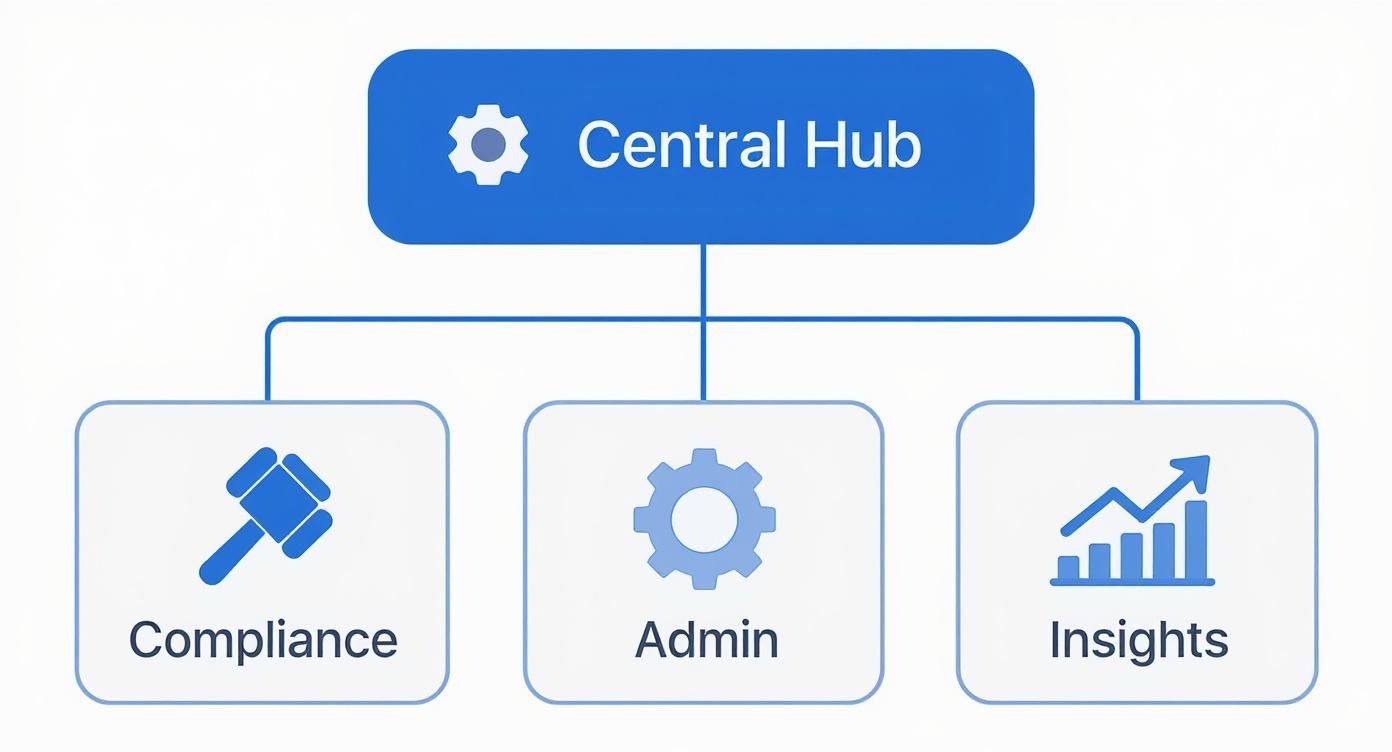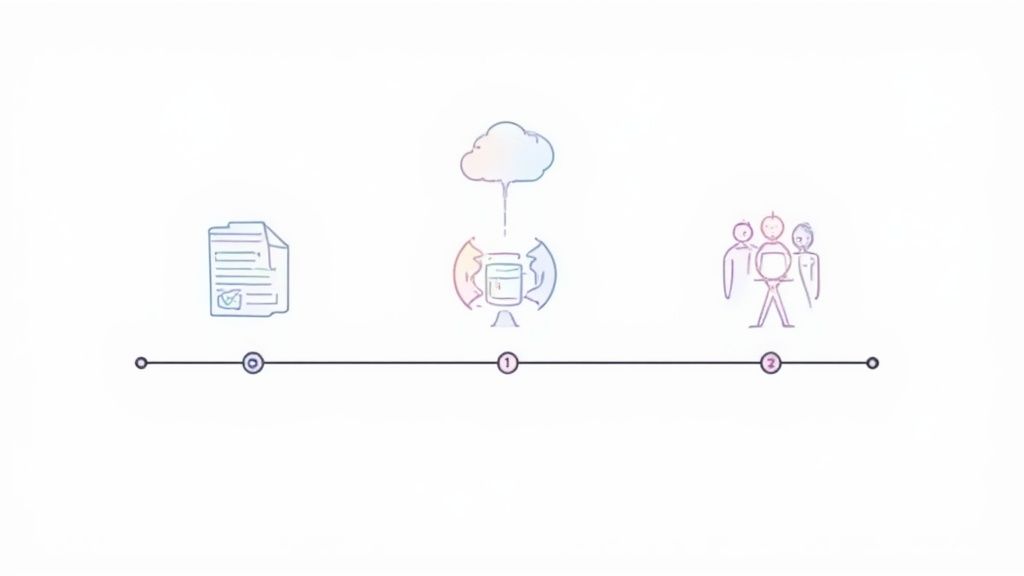
absence management software: streamline UK compliance today
Posted by Robin on 25 Oct, 2025 in
Absence management software is a digital tool that helps organisations track, manage, and analyse employee time off. Think of it as a central command centre for all types of leave, replacing messy spreadsheets and endless email chains with an organised, automated system.
Moving Beyond Manual Leave Tracking
Imagine trying to manage a busy airport's flight schedule using just a pen and paper. It would be chaotic, riddled with errors, and almost impossible to get a clear picture of what’s happening. For many businesses, that's exactly what managing employee leave with spreadsheets and manual processes feels like. This is where absence management software steps in to act as your company's digital air traffic control.
This software is much more than just a fancy digital calendar. It's a single, central hub for every kind of leave—from annual holidays and sick days to more complex situations like parental or compassionate leave. It cuts through the daily chaos of manual tracking by automating requests, approvals, and record-keeping.
The Core Problems of Manual Systems
Without a proper system, businesses often find themselves wrestling with persistent and costly issues. These outdated manual methods create a surprising amount of friction and risk for the company.
- Costly Compliance Errors: Manually calculating holiday accruals or Statutory Sick Pay (SSP) is a minefield. One small miscalculation can lead to non-compliance with UK employment law, opening the door to fines and legal headaches.
- Administrative Overload: HR teams and line managers spend countless hours chasing paper forms, updating spreadsheets, and fielding the same questions about leave balances over and over. This admin burden pulls them away from more strategic, high-value work.
- Zero Visibility: Spreadsheets only show you what’s already happened. They can’t flag worrying patterns, like a specific department seeing a spike in unplanned sick leave, which might point to a deeper issue with workload or wellbeing.
An effective absence management system transforms leave tracking from a reactive, administrative chore into a proactive, strategic function. It gives you the data needed to understand workforce trends, support employee wellbeing, and make smarter staffing decisions.
A Strategic Asset for UK Businesses
Ultimately, this software isn't just another HR tool to tick a box; it's a fundamental asset for improving how your entire business operates. By bringing clarity, fairness, and efficiency to the leave process, it directly builds a healthier, more productive workplace. It guarantees every leave request is handled consistently and by the book, which builds trust and improves the whole employee experience.
The insights you gain from accurate data are invaluable. For example, spotting a rise in short-term sick leave before it becomes a full-blown crisis allows managers to step in with support. Understanding why accurate absence tracking is crucial for compliance is the first step toward reducing these risks. This shift from guesswork to data-driven management is essential for any modern UK business serious about operational excellence and creating a supportive company culture. By solving these core problems, the software lets everyone get back to focusing on what truly matters.
Key Features of Absence Management Systems
To really get what makes absence management software tick, you have to look under the bonnet. These systems aren't just glorified digital calendars; they're smart tools built to solve some of the most persistent and frustrating problems businesses face. Each feature works together, aiming to slash admin time, keep you compliant, and give a clear picture of what’s happening across the company.
This infographic breaks down the core functions into three main pillars: administration, compliance, and strategic insights.

As you can see, everything feeds into a central hub, which then powers these specialised areas to give you a complete handle on your workforce.
Let's unpack what these features actually do in practice.
Employee and Manager Self-Service
At the core of any good, modern platform is self-service. This is all about empowering your team to manage their own time off through a simple, easy-to-use portal. Instead of firing off an email to their manager or digging out a paper form, staff can see their remaining holiday allowance, check the team planner, and pop in a request in seconds.
This simple change frees up managers from the constant email tennis of manual requests. No more being a bottleneck. They get a notification, see the request alongside who else is off, and can approve or decline it with a click. The amount of time this saves for everyone is staggering.
A self-service portal changes leave management from a top-down admin chore into a transparent, team effort. It gives employees ownership and lets managers get back to meaningful work instead of chasing paperwork.
Centralised Team Calendars
One of the biggest headaches with tracking time off manually is the lack of a single, reliable source of information. The team spreadsheet might be out of date, a manager’s personal calendar says something else, and suddenly you’ve got a problem. Absence management software solves this with a real-time, central calendar or 'wall planner'.
This shared view shows everyone, instantly, who is off and when. For managers, it’s a game-changer for planning resources and making sure there’s enough cover. It stops those accidental approvals of overlapping holidays that can leave a team completely exposed. For employees, it lets them coordinate with their colleagues, nipping potential scheduling clashes in the bud.
Automated UK Compliance Engine
Trying to navigate UK employment law around leave and pay can feel like walking through a minefield. A standout feature of any quality system is its power to automate these fiddly calculations, acting as your compliance safety net.
- Holiday Accrual: The software automatically works out statutory and contractual holiday entitlement for everyone—full-time, part-time, and even zero-hour workers—ensuring you’re always accurate and fair.
- Statutory Sick Pay (SSP): It tracks sickness and calculates SSP eligibility and payments for you, taking the risk of human error out of a notoriously tricky area.
- Bradford Factor Scoring: Many systems include tools to calculate the Bradford Factor, helping managers spot potentially disruptive patterns of frequent, short-term absences in a consistent, objective way.
This isn’t just about convenience; it’s about seriously reducing risk. It's no surprise that 81% of HR leaders are planning to digitise their time and attendance processes, mostly because they need greater accuracy and peace of mind on compliance.
Reporting and Analytics
Perhaps the most powerful feature is the ability to turn raw absence data into genuinely useful intelligence. A spreadsheet can tell you who was off, but it can’t easily show you why things are happening. A proper system comes with reporting tools that let you:
- Identify Trends: Quickly spot if sickness is creeping up in a particular department, which might point to issues with workload, morale, or wellbeing.
- Analyse Absence Types: See the real breakdown of leave across the company, from planned holidays to unplanned sick days or family emergencies.
- Forecast Staffing Needs: Use past data to better predict when your busy holiday periods will be, helping you plan resources far more effectively.
This data lets you shift from being reactive—just dealing with absences as they pop up—to being proactive. When you understand the patterns, you can launch targeted wellbeing initiatives, adjust workloads, or offer support exactly where it’s needed, tackling the root causes of absence before they become major problems.
Strategic Business Benefits of This Software

While the features of absence management software are great for solving day-to-day admin headaches, their real power is in the ripple effects they create across the business. Bringing in a system like this isn't just an operational tweak; it's a strategic move with real payoffs in compliance, efficiency, and company culture.
Think of it like this: fixing a leaky pipe is a good repair. But installing a modern plumbing system that prevents leaks, improves water pressure, and lowers your bills? That's a strategic investment. This software is that modern plumbing system for your business—it smooths out the flow of information and stops costly problems before they even start.
Secure Airtight Compliance and Risk Reduction
For any UK business, staying on the right side of employment law is a huge deal. The rules around sick pay, holiday entitlement, and parental leave are notoriously complex and always seem to be changing. Trying to track all this manually on spreadsheets isn't just clunky; it's a massive business risk. One wrong formula or an outdated record could easily land you in a costly legal dispute.
Absence management software is your shield against these risks. It automates calculations for Statutory Sick Pay (SSP) and holiday accrual based on the latest UK regulations, taking human error out of the equation. The system makes sure every employee's leave is tracked and calculated by the book, giving you a consistent and fully auditable record.
This isn't just about dodging penalties. It's about building a fundamentally fair system where everyone on the team is treated equitably—the very foundation of a positive and trusting workplace.
UK businesses are increasingly turning to this software not just for efficiency, but specifically for compliance and wellbeing. Our intricate employment law framework, including rules around flexible working and new family-friendly leave regulations, has made accurate absence tracking a non-negotiable part of doing business.
Unlock Major Gains in Operational Efficiency
The time saved by automating leave processes is one of the first things you’ll notice. Just think about the hours that managers, HR teams, and employees burn every week on manual absence admin.
- For HR Teams: Say goodbye to endless data entry, building reports from scratch, and answering the same questions about leave balances over and over. This frees them up to focus on the bigger picture, like talent development and employee wellbeing.
- For Managers: Approving leave becomes a one-click job instead of a messy trail of emails and calendar updates. They get an instant view of team availability, making it much faster and easier to plan resources.
- For Employees: The self-service portal puts them in control. They can manage their own leave quickly and see exactly what's going on, which cuts down on frustration for everyone.
These small pockets of saved time, multiplied across your entire workforce every single day, add up to a serious boost in productivity. The business simply stops wasting valuable time on admin friction.
Fuel Data-Driven Workforce Decisions
A spreadsheet can tell you who was off sick last Tuesday. An absence management system, on the other hand, can tell you why sickness rates in one department have climbed by 20% over the last quarter. That's the leap from basic record-keeping to genuine strategic insight.
The analytics and reporting tools turn your absence data into a powerful way to manage proactively. When you can see trends developing, you can move from reacting to problems to getting ahead of them. For instance, if you spot a pattern of burnout-related absences in your customer support team, you can step in with support or adjust workloads before it spirals into long-term sickness and resignations.
This data-driven approach helps you make smarter, more empathetic decisions that genuinely support your team's wellbeing. And when your team is supported, your business performance is protected. These benefits go way beyond ticking a compliance box, helping with wider HR goals like boosting employee engagement and motivation.
How to Choose the Right Absence Management Software
Picking the right software for your business can feel like navigating a maze. With so many options out there, it’s easy to get overwhelmed. But with a clear plan, you can make a confident choice that pays dividends for years to come.
The goal isn't just to find any tool; it's to find the right tool. You need something that fits your unique operational needs, your company culture, and of course, your budget.
The very first step is a simple but crucial one: look inwards. Before you even watch a single demo, you need to have a solid grip on your own requirements. Think about the specific headaches you're trying to get rid of. Are you drowning in holiday request forms, worried about UK compliance, or just struggling with a basic lack of visibility over who’s off and when?
Assess Your Unique Business Needs
Every business is different. A creative agency with 20 people has vastly different needs from a 200-person manufacturing company juggling complex shift patterns. Getting a clear picture of your starting point is essential for making a good decision down the line.
Start by mapping out your non-negotiables:
- Team Size and Structure: How many employees are you managing? Are they full-time, part-time, or on variable-hour contracts? Do you operate from one location or have multiple sites to coordinate?
- Leave Policies: Think beyond standard holidays. Do you offer enhanced maternity pay, compassionate leave, or time off in lieu (TOIL)? Your chosen software absolutely must be able to handle these custom rules without breaking a sweat.
- UK Compliance Focus: How critical is it for you to automate things like Statutory Sick Pay (SSP) and holiday accrual? For most UK businesses, this is a top-tier requirement to minimise risk and stay on the right side of the law.
The best absence management software for you is the one that solves your biggest problems effortlessly. Don't get distracted by flashy features you'll never use. Focus on the core functionality that will genuinely make a difference to your daily operations.
Key Criteria for Evaluating Software
Once you’ve got your internal checklist sorted, you can start sizing up potential platforms. It’s time to look past the marketing promises and dig into how each system actually works. These three pillars will help you judge the true quality and suitability of any option you’re considering.
1. Scalability and Flexibility
Your business won't stand still, and your software shouldn't hold you back. Think about whether the platform can grow with you. Can it easily handle a sudden increase in headcount? How simple is it to add new leave policies or tweak approval workflows as your company evolves? A system that’s rigid today will quickly become a roadblock tomorrow.
2. Integration Capabilities
Your absence management software shouldn't be an isolated island of data. For maximum efficiency, it needs to connect seamlessly with the other tools you already rely on every day.
The most important connection is usually with your payroll system. An automatic link ensures that unpaid leave, sick pay, and holiday pay are processed accurately without any manual data entry, saving huge amounts of time and preventing costly errors. It's also worth checking for integrations with tools like Slack or Google Calendar to keep everyone in the loop.
3. User Experience (UX)
This is arguably the most important factor of all. If the software is clunky, confusing, or just a pain to use, your team simply won't adopt it. No matter how many features it has.
Look for a clean, intuitive interface that makes sense from day one. A great user experience means employees can request leave in seconds and managers can approve it with a single click—no lengthy training manual required. For a deeper dive into what makes a great platform tick, exploring a comprehensive guide to employee leave management systems can be incredibly helpful.
Questions to Ask During Demos
A live demo is your golden opportunity to see the software in action and ask some tough questions. Don’t be a passive observer; use this time to verify the platform’s claims and see if it really fits your needs.
Here is a quick checklist of essential questions to have ready:
- Can you show me exactly how the system handles part-time holiday accrual?
- How is customer support handled? Is it based in the UK and available during our business hours?
- What does the implementation process look like and how long does it typically take?
- Can you demonstrate how it integrates with our specific payroll software?
For those thinking about how absence management fits into a broader HR technology stack, reviewing top workforce management software options can offer some valuable context. Taking this structured approach ensures you choose a partner, not just a product.
Getting Your New System Up and Running Successfully

A great tool is only as good as its rollout. Bringing in new absence management software is a huge step forward, but making sure the switch is seamless comes down to a smart implementation plan. This blueprint will walk you through the process and set you up for success right from day one.
The journey doesn't actually start with the software. It starts with your data. A successful migration is your chance for a fresh start, a clean break from the messy world of old spreadsheets and scribbled notes.
Prepare and Migrate Your Data
Before you even think about importing anything, take this chance to give your existing absence records a proper clean-up. This means fixing errors, making sure everything is in a standard format, and checking that all your historical data is spot on.
Putting in this effort upfront stops you from carrying old problems into your shiny new system. It's the only way to guarantee your starting leave balances are correct and your reports will be trustworthy from the get-go. Once your data is tidy, the migration can begin, moving all your employee information and leave history securely into the new platform.
Configure Your Policies and Workflows
With your clean data safely in place, it's time to shape the software to fit your company's unique DNA. This is where you configure the system to mirror your specific leave policies—from annual holiday entitlement to the rules for compassionate leave or TOIL.
This stage is also absolutely critical for UK compliance. You’ll need to set up rules for things like:
- Holiday Accrual: Defining exactly how entitlements are calculated for your full-time, part-time, and variable-hour staff.
- Approval Workflows: Deciding who signs off on requests for different teams or types of leave.
- Statutory Pay: Ensuring the system is correctly set up to handle Statutory Sick Pay (SSP) and other legal must-haves.
This customisation is what makes the software work for you, not the other way around. To make sure you're hitting all the right notes, have a look at our step-by-step guide to implementing an absence management system.
Drive User Adoption and Training
Here comes the most important part of any implementation: getting your people on board. A simple, clear communication plan is essential to build a bit of excitement and make sure everyone understands the benefits. Explain why the change is happening and how it will genuinely make their working lives easier.
A successful launch isn't just about the technical setup; it's about winning the hearts and minds of your team. Focus on clear communication and practical training to turn employees and managers into enthusiastic advocates for the new system.
Make sure your training sessions are tailored to different groups. Your employees just need to know how to request leave and check their balance. Managers, on the other hand, need to be comfortable approving requests and viewing team calendars. Keeping it simple and role-focused is the key to success.
Go-Live and Gather Feedback
After all the planning and training, it’s time for the official launch. Keep a close eye on the system during the first few weeks so you can quickly jump on any teething issues or user questions. The implementation doesn't just stop at "go-live"—it evolves.
Actively ask for feedback from employees and managers to pinpoint areas for improvement. This continuous feedback loop helps you refine workflows and get the absolute maximum value from your investment. And it's an investment more companies are making; the UK’s absence management software industry saw its revenue share grow by an incredible 73.17% between 2021 and 2025. It’s a clear sign that businesses are waking up to how powerful these tools can be.
Your Questions, Answered
Thinking about a dedicated absence management system? Here are some quick, clear answers to the questions we hear most often from UK businesses.
Is This Kind of Software a Good Fit for a Small UK Business?
Absolutely. Gone are the days when powerful software was just for big corporations. Modern cloud-based systems are built to scale, and most providers offer pricing based on your headcount, making them genuinely affordable for any size of company.
For smaller businesses, it's a real game-changer. You get an easy way to stay on top of complex UK rules like holiday pay and Statutory Sick Pay (SSP). More than that, you claw back huge amounts of admin time and present a much more professional face to your team, helping you attract and keep great people.
How Does This Software Handle Tricky UK Leave Types?
The best systems designed for the UK market are built from the ground up to manage complicated leave policies, like Shared Parental Leave or compassionate leave, without any fuss.
You can set up custom rules, track those tricky intermittent days off, and have the system calculate the correct entitlements automatically. It completely gets rid of the high risk of human error you get with a spreadsheet, protecting your business and making sure your employees are treated fairly.
Can This Software Talk to Our Payroll System?
Yes, and this is where you’ll see some of the biggest benefits. Integration is a core feature for most top-tier platforms. They come with ready-made connections to popular UK payroll and HR software, creating a smooth, automatic flow of information.
This means data on sick pay, holiday leave, and unpaid days moves straight over to payroll each month. The result? Fewer mistakes, far less manual data entry, and the confidence that your team is always paid accurately. It’s no surprise that 81% of HR leaders are moving their time tracking online to get this kind of automation.
Ready to ditch the spreadsheets and get a crystal-clear view of your team's leave? Leavetrack offers a simple, powerful, and affordable absence management system designed specifically for UK businesses. Start your free trial and see the difference today.
